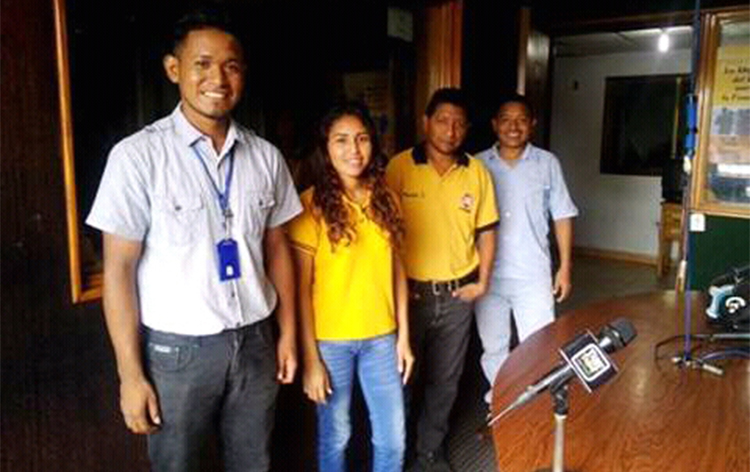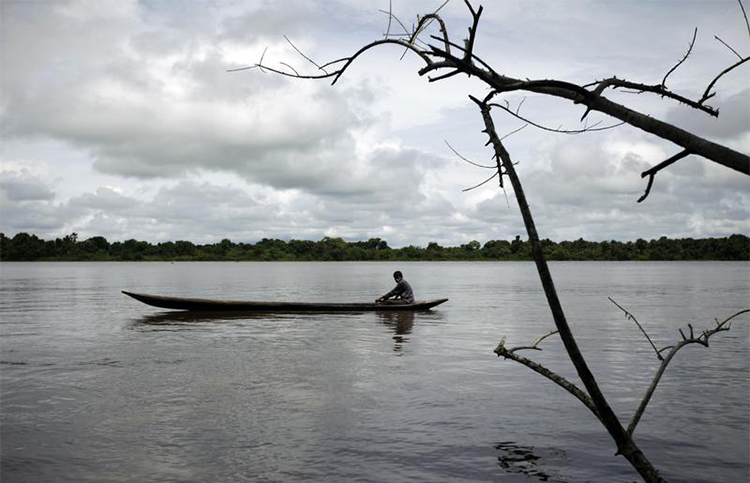Three twentysomethings huddle over a desk in a small room in Tucupita, a low-slung city of about 90,000 people that spills across the Orinoco river delta region in northeastern Venezuela. Far from the tear gas and street conflicts roiling cities including Caracas and Valencia, these journalists are focused on reporting the latest story from the delta, hoping to publish before the power goes out.
Losing power is a regular occurrence for the staff of Tane Tanae, a news site serving Delta Amacuro, a vast rural state in one of Venezuela’s poorest regions. The website’s name means “that’s how it went” in the language of the Warao, the largest indigenous community in a region that relies heavily on state aid.
Sometimes the electricity cuts out because of flooding, storms or the unreliable connections common to rural areas. On other occasions, supporters of local political figures who are unhappy at the outlet’s critical reporting disconnect the cables, Alba Perdomo, a journalist and member of Venezuelan press freedom organization Institute for Press and Society (IPYS), told CPJ in a phone interview earlier this year.
Journalists in Venezuela regularly face harassment, intimidation, detention, and censorship, CPJ has found. Yet the dangers are greater for journalists from indigenous communities, or those working for small community media outlets who seldom have access to the basic protections available to those affiliated with major publications.
Instead, they make do with the resources available to them–outdated technology, unreliable phone service, word-of-mouth–to report on land conflicts, trafficking, and extraction industries. It’s a beat that provides endless opportunities for reporting, but also constant threats of violence.

Tane Tanae‘s coverage of issues such as healthcare, corruption, and contraband smuggling has led to clashes with local officials, who its reporters say view Tane Tanae as part of the political opposition.
The site’s co-founder and editor Amador Medina told CPJ that in April, regional officials told him that the site appeared on a list of digital media outlets that might be blocked by authorities–an increasingly common practice in Venezuela’s polarized digital landscape.
CONATEL, the state telecommunications regulator, did not immediately respond to CPJ’s emailed request for comment.
“[Tane Tanae is] the only critical media outlet left,” said Perdomo. “This makes some people uncomfortable and causes problems, especially when it has to do with corruption.”
Perdomo cited an incident in 2016, when two men on a motorcycle yelled death threats against Medina after Tane Tanae published an article alleging that an official was connected to a construction project on indigenous lands. Separately, Medina told CPJ that a Tane Tanae journalist received a phone call in June from an unidentified person who instructed the journalist not to publish anything about criminal groups operating in Delta Amacuro. [Editor’s note: The journalist’s name has been withheld for security reasons.]
All of the journalists with whom CPJ spoke described a tense relationship between Tane Tanae and the governor of Delta Amacuro, Lizeta Hernández, who has publicly accused reporters from Tane Tanae and the Fe y Alegría radio station of inciting violence. Medina said that he believes their reporting upset the governor’s supporters, and views the threats against him and the outlet as attempts to silence a critical voice.
Hernández’s office did not respond to CPJ’s emailed request for comment.
Tane Tanae’s confrontational relationship with local power brokers means many political figures choose not to buy advertising, Perdomo said. Many news outlets in Delta Amacuro receive most of their advertising revenue from government-sponsored advertisements and political campaigns. Perdomo said that some business owners make a point of buying advertisements to support the site, but a lack of government support has affected Tane Tanae‘s bottom line.
To get around these challenges, including what Perdomo described to CPJ as “electric censorship,” the staff rely on the kindness of neighbors who provide support–from using word of mouth to share news articles with those who can’t access the internet, to passing an ethernet cable or an extension cord through the newsroom window during power cuts.
In a region with low connectivity, a history of marginalization and high illiteracy rates, an online news portal might seem ineffective at best. Yet the reporters of Tane Tanae, and the non-indigenous journalists who support them, say it is a necessary step toward greater representation and awareness for indigenous communities like the Warao.
Before Tane Tanae, the online version of El Periódico del Delta was the capital’s only digital news source. Within this restricted media landscape, a locally-led and -oriented news outlet quickly became a vital alternative source of information. “As a media outlet, we’re breaking this stigma [toward our community],” said Medina.
Eldrys Valenzuela, a reporter for El Periódico del Delta, the state’s only major print newspaper, said, “The Warao tend to be very closed off, so it’s surprising that it’s these same Warao people who go out to their communities and report on these difficult topics.”
Perdomo, who has spent more than 14 years working with IPYS, coordinated the original training session for staff at Fe y Alegría in early 2015 that helped inspire a group of Warao youth to create Tane Tanae.
“Two of us from this group decided we wanted to create a website to show what we had learned,” said Medina, a 27-year-old, who began working at Fe y Alegría when he was 18. “So we created Tane Tanae, maintaining this philosophy of prioritizing our community.”
With the support of Fe y Alegría general manager Francisco Pérez, the seven-person team set up an office in a small room in the station. The space has five desks, a few computers and no television–hardly luxurious, but enough to get the job done.
“We’re not professionals, but we know that no other outlet is doing what we’re doing, uncovering the reality both for the indigenous community and the general population,” said Medina. “In Venezuela, there are very few media outlets that have indigenous journalists. It’s very difficult to understand indigenous communities, so if we ourselves don’t take responsibility for it, nobody will do it.”
In the past year, Tane Tanae has reported on issues including maternal health care, rising HIV/AIDS rates, inadequate housing and displacement across the state. “Tane Tanae are the only ones who talk about some of these things,” said Perdomo. “That’s why they’re so necessary. They show another side of our Venezuelan reality.”
Medina said that he sees Tane Tanae as a potential model for other indigenous journalists. “In spite of the threats, we want to continue being an example, to keep going with this media outlet that was born out of the Warao community,” he said. “There are so many indigenous populations that need this kind of access to information. We want people to be informed about their own situation, and we want to continue changing part of the story of the community here.”
